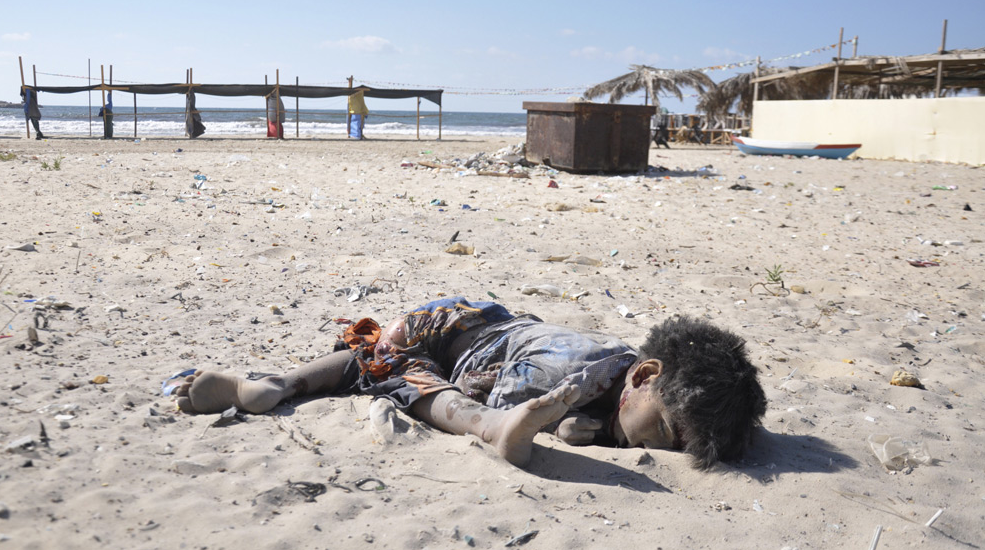
Yes, this is the same photo featured in our Sunday post. Michael Humphrey commented on that post with the accusation that it was animated by “moral idiocy” masquerading as “moral seriousness.” His argument is that publishing photographs that underscore the notion that “war is hell” don’t accomplishing anything without being accompanied by a “serious statement.” His position is a serious one, and indeed something of a conventional piety that gets repeated often and again by any number of iconoclasts (most notably Susan Sontag) and it deserves serious response.
The iconoclastic position is simple enough: photographs can at best be only a surge of raw emotional energy that is devoid of the rational capabilities necessary for ethical relationships; this is so, as the photograph—by itself—cannot provide moral knowledge. Accordingly, the viewing public is locked into a passive spectatorship that leaves little room for anything like serious moral engagement (i.e., at its best something like compassion fatigue, at its worst, “moral idiocy masquerading as moral seriousness”). Photography may be put to better or worse uses but remains a profoundly suspect medium of representation, indeed one that is presumably and inherently fraudulent because the image can never provide the adequate knowledge of reality that is promised.
The argument assumes that photography bears the burden of representation, which is to say that the “truth” of any photographic image is mitigated by the fact that it always offers a partial and limited view of the world—and in its most extreme forms the argument is that photographs offer little more than fantasy, deceit, and manipulation. So far so good, as any medium—not least, the spoken and written word—is subject to precisely the same limitations. The difficulty is that proponents of this position place the full burden of representation on the photograph with the assumption that its inherent inadequacies can be solved by turning to the word (i.e., “serious statement”) without recognizing that rational discourse and verbal narratives are no less subject to the exact same problem. To get the point, note how discussions of photographs often underscore the fact that we need to “know more than is shown” or that the “context” needs to be elaborated, but we never see rational or narrative reports that include serious discussion of the inadequacy of the word to fully explain a situation.
Ultimately, all media are mixed media, and the image needs the word as much as the word needs the image, so this is not an argument against “serious statement.” It is, however, an argument in favor of taking the photographic image on its own terms and to be willing to “think” with and through it. That is, not just to look at it, but to see what is being shown on its own terms and to seriously consider its implications. Mr. Humphrey quotes a Washington Post editor who is altogether blithe in conceding that “war is hell” as a simple matter of fact without being willing to interrogate its particular hellishness (as displayed in the photograph of carnage) apart from a “serious statement,” and in so doing creates the conditions for normalizing our attitudes towards war as a taken for granted assumption. What matters then are the rational causes for conflagrations and not the affective or moral implications of the body of the dead child that the photograph above forces us to stand in witness to.
Mr. Humphrey assumes a degree of “moral clarity” to the political situation in the Middle East. Maybe from his perspective it is morally clear, but I don’t quite see it. When I allow myself to think with and through the above photograph on its own terms, however, I find myself questioning the world in new and different ways as it invites consideration of what is at stake when we concede that “war is hell” and move on to other matters. Are we comfortable participating in a world that assents to the normalization of war as a taken for granted assumption and, more, one that accepts any rationale whatsoever as justification for the murder of children? Whatever the answer to these questions, the point is that the photograph invites—perhaps demands—their asking, and it such invitations/demands that coaches moral seriousness.
Photo Credit: Stringer/Reuters
[…] In Camera | Second Look (No Caption Needed) Two posts by John Louis Lucaites on a photograph of a dead child on a Gaza […]